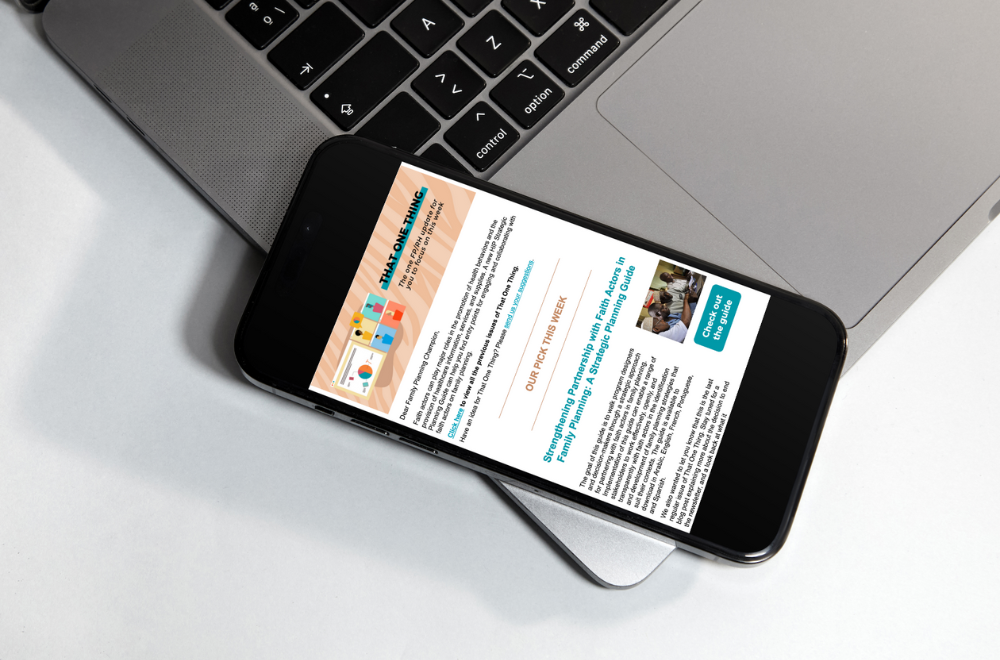When to Stop Publishing an Email Newsletter

After three years, we’re ending our popular “That One Thing” email newsletter. We share the history of why we started That One Thing in April 2020, and how we decided it was time for the newsletter to come to a close.
Email newsletters are tremendously popular among projects and organizations working in family planning and reproductive health (FP/RH). Email is an effective way to reach many people: It’s relatively accessible across many Internet settings and people can keep emails in their inboxes indefinitely, searching them later for information they need. Newsletters can include a lot of information in one convenient place and they’re relatively easy to pull together. But once you start an email newsletter, how do you stop? And if you end a newsletter, is it a failure?
The Story Behind That One Thing
The story behind one of our email newsletters, That One Thing, and our recent decision to end it takes us back to 2020. The COVID-19 pandemic had moved nearly all work online (and all of us inside). Meetings and conferences suddenly switched to video conferencing platforms, and an overwhelming number of emails started filling inboxes every day. Most of those emails focused on a really important topic: how to maintain FP/RH programs and services in the face of new restrictions, supply chain disruptions, and threats to the health and safety of both personnel and patients. Unfortunately, their content was easily lost in the flood of communications and, confined to our homes and overloaded with work and personal obligations, many of us felt unable to keep up with it all.
That One Thing promised to help by recommending “the one update in family planning and reproductive health that you need to focus on this week.” Delivered as a concise weekly update, we used visual cues to make it easy for readers to scan the email and find what they needed, quickly. Our first issue in April 2020 highlighted Breakthrough ACTION’s guidance on social and behavior change for family planning during COVID-19. More than three years later, we’ve shared nearly 165 tools, resources, research articles, and newsworthy items from FP/RH organizations and projects.

Using Email Analytics Data for Decision-Making
We keep a close eye on engagement among subscribers for all our email newsletters. That One Thing had high open rates, but over time, its click rate declined and stayed low. This told us that while subscribers might enjoy seeing what resource was chosen each week, most of them weren’t using That One Thing emails to access those resources. Click rates were much higher in other Knowledge SUCCESS email newsletters that shared some of That One Thing’s subscribers. This told us that the low click rate wasn’t due to a behavioral barrier: our readers would click if they really wanted to view more.
“Open rate is the percentage of subscribers who open a specific email out of your total number of subscribers. Click rate is the percentage of people who click on a link or image within an email. ”
Our goal is helping people to find, share, and use information they need for work. We know that those needs change over time. Sometimes, you can shift the focus of a knowledge management (KM) product (like newsletters) to meet those new needs. And sometimes, it’s okay to end. That One Thing started as a way to reduce clutter in inboxes and connect people to timely, useful resources. We spent a year watching the data; when click rates didn’t change, it meant That One Thing was likely contributing to the problem it meant to solve.
Looking Back on That One Thing
We appreciate all the emails we’ve received since 2020 from subscribers sharing new resources, commenting on our selections, and sometimes just saying hello. Ending That One Thing not only maintains the quality of content for our other newsletters, but also respects your time and attention and allows us to find fresh ways to meet knowledge needs. With this approach, we believe that That One Thing’s legacy endures beyond its final issue.
A final note to those of you who publish email newsletters for readers in Africa: offer them in French! The open rate for the French version of That One Thing, which was sent to a separate list, was seven percent higher than the open rate for the English version. Since the newsletter launched, 49% of That One Thing pageviews on the Knowledge SUCCESS website have been of its French versions. The data shows that if we provide resources in French, people use them.
A special thank-you to our Knowledge SUCCESS colleagues (past and present) who have contributed to That One Thing since it launched: Irene Alenga, Sonia Abraham, Anne Ballard Sara, Cozette Boakye, Alison Bodenheimer, Grace Gayoso Pasion, Brittany Goetsch, Sarah Harlan, Diana Mukami, Tykia Murray, Alex Omari, Collins Otieno, Pranab Rajbhandari, Frederick Rariewa, Ruwaida Salem, Marla Shaivitz, Aissatou Thioye, Elizabeth Tully, Sophie Weiner




